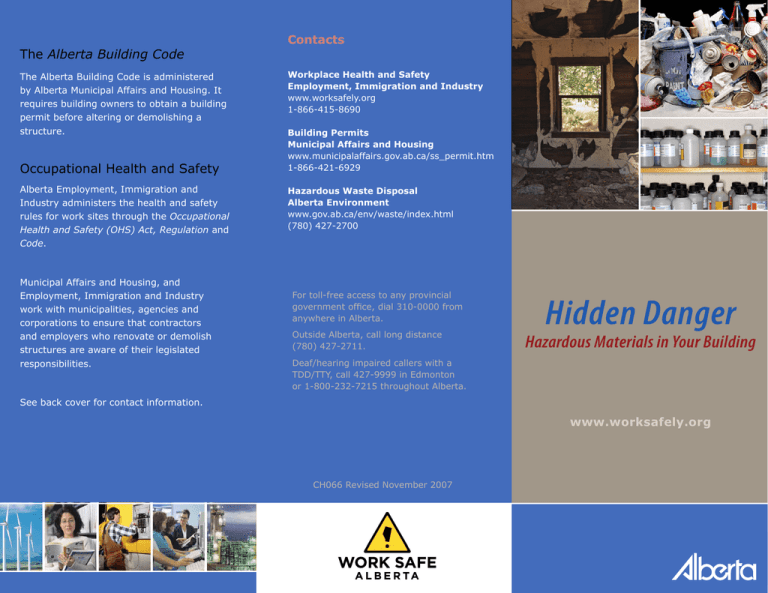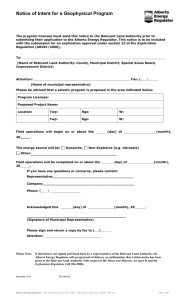Hidden Danger - Hazardous Materials in Your Building (Bulletin
advertisement

The Alberta Building Code The Alberta Building Code is administered by Alberta Municipal Affairs and Housing. It requires building owners to obtain a building permit before altering or demolishing a structure. Occupational Health and Safety Alberta Employment, Immigration and Industry administers the health and safety rules for work sites through the Occupational Health and Safety (OHS) Act, Regulation and Code. Municipal Affairs and Housing, and Employment, Immigration and Industry work with municipalities, agencies and corporations to ensure that contractors and employers who renovate or demolish structures are aware of their legislated responsibilities. Contacts Workplace Health and Safety Employment, Immigration and Industry www.worksafely.org 1-866-415-8690 Building Permits Municipal Affairs and Housing www.municipalaffairs.gov.ab.ca/ss_permit.htm 1-866-421-6929 Hazardous Waste Disposal Alberta Environment www.gov.ab.ca/env/waste/index.html (780) 427-2700 For toll-free access to any provincial government office, dial 310-0000 from anywhere in Alberta. Outside Alberta, call long distance (780) 427-2711. Hidden Danger Hazardous Materials in Your Building Deaf/hearing impaired callers with a TDD/TTY, call 427-9999 in Edmonton or 1-800-232-7215 throughout Alberta. See back cover for contact information. www.worksafely.org CH066 Revised November 2007 www.worksafely.org If there are materials containing asbestos in a structure, the contractor or employer must: •remove or enclose the material in a renovation area; There may be a hidden danger in your building Before you start your renovation or demolition project, you need to know about hazardous materials. They can pose a danger to your employees, contractors and you. Health and safety is important to everyone. Hazardous materials can include chemical substances such as: • building materials containing asbestos • non-asbestos insulation matierals such as fiberglass and refractory ceramic fibre • lead paints • mercury (fluorescent lights, switches, gauges) • polychlorinated biphenyls or PCBs (liquid-cooled equipment, light ballasts, paints, electrical insulating materials) • oils and lubricants • batteries and fuels • paints and thinners • glues and solvents • cooling system chemicals such as freon • compressed gases • welding rods and solder • other hazardous chemicals Hazardous materials can include biological substances such as mould and bacteria from human or animal wastes, including: •remove the material prior to demolition; •notify Workplace Health and Safety before the materials are removed, • sewage • manure • bird and rodent droppings • dead animals enclosed or encapsulated; and •ensure workers involved in the removal, enclosure or encapsulation of the material have additional training specific to these activities. An employer must: • assess hazards at the work site before work begins • ensure workers are protected from hazards at the work site • ensure work procedures are developed when a worker may be exposed to a harmful substance • ensure workers are properly trained to deal with hazards at the work site • obtain a permit from the appropriate municipal agency, as required • properly dispose of hazardous waste • properly abate building materials containing asbestos prior to demolition or renovations

